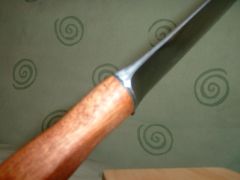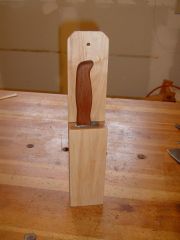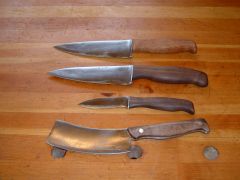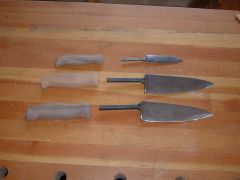
northboundtrain
Members-
Posts
30 -
Joined
-
Last visited
Recent Profile Visitors
The recent visitors block is disabled and is not being shown to other users.
-
I've wondered if it would be possible to use biodiesel for a forge fuel. Looks like you answered the question. Is it 1200 degrees Fahrenheit or Celsius? It would certainly have to get hotter than 1200 F. I assume that since you are in Sweden you mean Celsius.
-
Indoor Charcoal Forge Design
northboundtrain replied to northboundtrain's topic in Blacksmithing, General Discussion
Yeah, that's what I'm doing now -- using a little propane forge outside. It works well. However, I burn wood to heat the shop in winter, and it would be great to use that wood for forging while it's heating as well. Also, the propane forge is loud, and I understand that charcoal is better for making knives and tools because it doesn't strip carbon away from the steel like propane does. Plus, I think I would really enjoy forging the way the blacksmiths of old did it. I'm now thinking of making a small forge and shoehorning it in next to the wood stove. Then wye the pipes together before they enter the chimney. That way, I could be making charcoal in the stove while I'm forging (That would get the shop pretty toasty.) -
Indoor Charcoal Forge Design
northboundtrain replied to northboundtrain's topic in Blacksmithing, General Discussion
I just read the charcoal making tutorial again over at Tim Lively's site. I don't think I would want to try the indirect method inside the shop -- seems a bit dicey. I understand that a retort produces more charcoal, but If I'm heating the space while making charcoal the direct way, then nothing is really wasted. I'm just not sure I would be able to make enough charcoal in such a small (approx 3 cu. ft.) fire box. My space is really small. It is a one car garage, 16' x 24', with work benches and tools running down each of the long walls. I just barely manage to get my full-size truck inside. The forge would have to occupy the same space -- approx. 2' x 2' -- that the woodstove currently does. I really like the idea of forging with charcoal, especially in winter when it would heat the shop as well. Maybe if the forge can't produce enough charcoal, I could build a one-drum retort and do the initial heat with propane before the wood starts giving off gasses and the process becomes self-sustaining. As long as the retort didn't give off too much smoke, I could probably get away with it. -
Indoor Charcoal Forge Design
northboundtrain replied to northboundtrain's topic in Blacksmithing, General Discussion
So would it be feasible to make charcoal in a firebox that is 16"W x 16"H x 20"D? That's about 3 cu. ft. I figure that when I use the forge for space heating, I would make charcoal as much as possible. Since I see forging as only a hobby for me, I wouldn't need a huge amount of charcoal. -
Indoor Charcoal Forge Design
northboundtrain replied to northboundtrain's topic in Blacksmithing, General Discussion
Yeah, charcoal that I make from hardwood. -
So I've definitely be bit by the blacksmithing bug. My little propane forge has worked well enough to get me hooked. However, If this is to become a serious hobby, I'd like something different. Currently, I have a woodstove in the garage. I'm thinking of taking out the stove and replacing it with a homemade forge. I envision a forge built like a masonry heater with a steel door on the fire box that could be closed so that the forge could double as a heater. Also, I would want to make the charcoal itself in the forge. I can't be lighting fires under 55 gallon drums full of wood in this neighborhood (read, suburbia ). So to sum up, the forge would serve three purposes: forge, heater, and charcoal maker. When I lived in the country I did build a masonry heater once for an outbuilding that worked quite well. It was essentially a box of mortared firebrick with a six inch hole in the top for a stove pipe and another hole in top for a steel lid. A smaller hole toward the bottom served as an air inlet, which I controled with a tapered piece of brick. I'm thinking of a similar design, but modified as necessary for forging. Any thoughts, suggestions? BTW, my garage is small and space is very limited as it is, so keeping the stove and adding a forge is not an option. Thanks
-
Yeah, I tested them all. The cleaver works pretty well for chopping. It has a thicker blade and blunter edge angle, so it is for heavier work. I'm finding that blade and handle ergonomics are everything. A few degrees off makes a big difference. I think the best of the bunch is the mahogany handled chef knife (the lighter colored handle; the others are walnut). I'm giving that one away tomorrow as a wedding gift. The others will be my daily knives until I make better ones (if that ever happens). Hey thanks to whomever did the thumbnail attachment. I haven't been able to do those myself because the size of my pics is too big.
-
I just finished four kitchen knives. The two chef knives and the cleaver looking thing were forged from a leaf spring off an '80s vintage Toyota pickup. I'm guessing that it is 5160 because an earlier attempt to quench a blade in water resulted in several cracks. Any other thoughts/suggestions on what the steel might be? The smaller paring knife is made from 1095 that I bought to make some woodworking plane irons a few months ago (those blades still haven't needed to be resharpened since I first started using them ). I quenched all the blades in peanut oil and tempered them with a little mapp torch. I aimed for blue along the spine and straw/bronze at the edge out to bronze/purple at the tip. The hidden tangs (3/8" rebar on the chef knives and a 40 penny nail on the paring knife) were mig welded to the bolsters. Next time I'd like to try and forge the whole knife -- blade and tang -- out of one piece. That seems like the more professional way to do it. The chef knives are about 11-12 inches overall with approx 6 1/2 inch blades. http://www.iforgeiron.com/gallery/showphoto.php/photo/894/cat/500
-
Need Help with Forge
northboundtrain replied to northboundtrain's topic in Blacksmithing, General Discussion
Well, my forge is working much better. I added more brick to the inside to make the firebox smaller, and the biggest improvement was getting rid of the burner grill and just having a nice big hole. The problem was that the fire was blowing itself out with the LP pressure turned up too high or the blower going too much. I think the grill messed with the flame and air flow. Now I can run higher pressure and more air. Increasing the orfice size was counterproductive; it made the flame blow out more easily. I welded the hole shut and went back to #65. Hopefully, I'll have some knives to show soon. -
Hey Lugnut, I'm up in Boulder, and I'm just beginning to teach myself too. My main interest right now is knives and woodworking tools (chisels, plane irons, etc.). Drop me a note if you are ever up this way. Jeff
-
Need Help with Forge
northboundtrain replied to northboundtrain's topic in Blacksmithing, General Discussion
Update: I packed out the inside of the forge with firebrick. It helped maybe a little but not enough. Then I went out and got some drill bits: #62, #60, and #58. I'll try enlarging the orfice incrimentally and see what happens. I also bought a 4" duct fan that I will install on the air intake. The compressor set up does not allow for continuous forced air (the compressor would run constantly which it is not designed to do). So here's a question: If I feel like I should be wearing ear plugs while hammering (because I'm getting a loud sharp ring) does that mean that the metal isn't hot enough?



